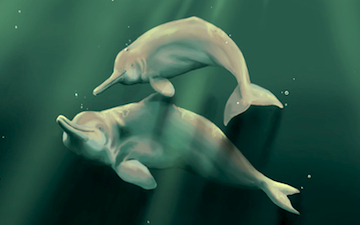The Baiji (Chinese: 白鱀豚; pinyin: ![]() báijìtún (help·info)) (Lipotes vexillifer, Lipotes meaning “left behind”, vexillifer “flag bearer”) was a freshwater dolphin found only in the Yangtze River in China. Nicknamed “Goddess of the Yangtze” (simplified Chinese:长江女神; traditional Chinese: 長江女神; pinyin: Cháng Jiāng nǚshén) in China, the dolphin was also called Chinese River Dolphin, Yangtze River Dolphin, Whitefin Dolphin and Yangtze Dolphin. It is not to be confused with the Chinese White Dolphin.
báijìtún (help·info)) (Lipotes vexillifer, Lipotes meaning “left behind”, vexillifer “flag bearer”) was a freshwater dolphin found only in the Yangtze River in China. Nicknamed “Goddess of the Yangtze” (simplified Chinese:长江女神; traditional Chinese: 長江女神; pinyin: Cháng Jiāng nǚshén) in China, the dolphin was also called Chinese River Dolphin, Yangtze River Dolphin, Whitefin Dolphin and Yangtze Dolphin. It is not to be confused with the Chinese White Dolphin.
The Baiji population declined drastically in recent decades as China industrialized and made heavy use of the river for fishing, transportation, and hydroelectricity. Efforts were made to conserve the species, but a late 2006 expedition failed to find any Baiji in the river. Organizers declared the Baiji “functionally extinct“,[3] which would make it the first aquatic mammal species to become extinct since the demise of the Japanese Sea Lion and the Caribbean Monk Seal in the 1950s. It would also be the first recorded extinction of a well-studied cetacean species (it is unclear if some previously extinct varieties were species or subspecies) to be directly attributable to human influence.
In August 2007, Zeng Yujiang reportedly videotaped a large white animal swimming in the Yangtze.[4] Although Wang Kexiong of the Institute of Hydrobiology of the Chinese Academy of Sciences has tentatively confirmed [5] that the animal on the video is probably a baiji, the presence of only one or a few animals, particularly of advanced age, is not enough to save a functionally extinct species from true extinction. The last known living baiji was Qi Qi (淇淇) who died in 2002.
(From Wikipedia.org, December 27 2010)
– – –
Baijis have long been recognised as one of the world’s rarest mammals, and are extremely shy animals, making observation of them in the wild extremely difficult. Consequently, relatively little is known of the species (6). They are most active through the night from early evening to early morning (3). They tend to live in small groups of three to four individuals, with the largest group ever seen comprising of 16 (2). A recent study found that they often swim with finless porpoises (Neophocaena phocaenoides), the only other cetacean in the Yangtze River, which is also threatened (classified as Endangered on the IUCN Red List) (1) (6). Baijis break the surface of the water without creating a splash and breathe smoothly (2). They feed on a wide range of freshwater fish (2), which are eaten whole (7). It is thought that breeding occurs in the first part of the year, with most births peaking between February and April (2).
(From ARKive via The Encyclopedia of Life, December 27 2010)
– – –




